“Building a plane while flying it” or some variation has been used to describe situations in education (2011), education (2016). education (2017), health care, medicine, ride-hailing startups, business strategy, even fluffier business stories, and…this. And long before earning broad criticism for its use in tech, the phrase was vividly illustrated in an ad for Electronic Data Systems (EDS) that has since been appropriated for all the circumstances named above, as well as building churches:
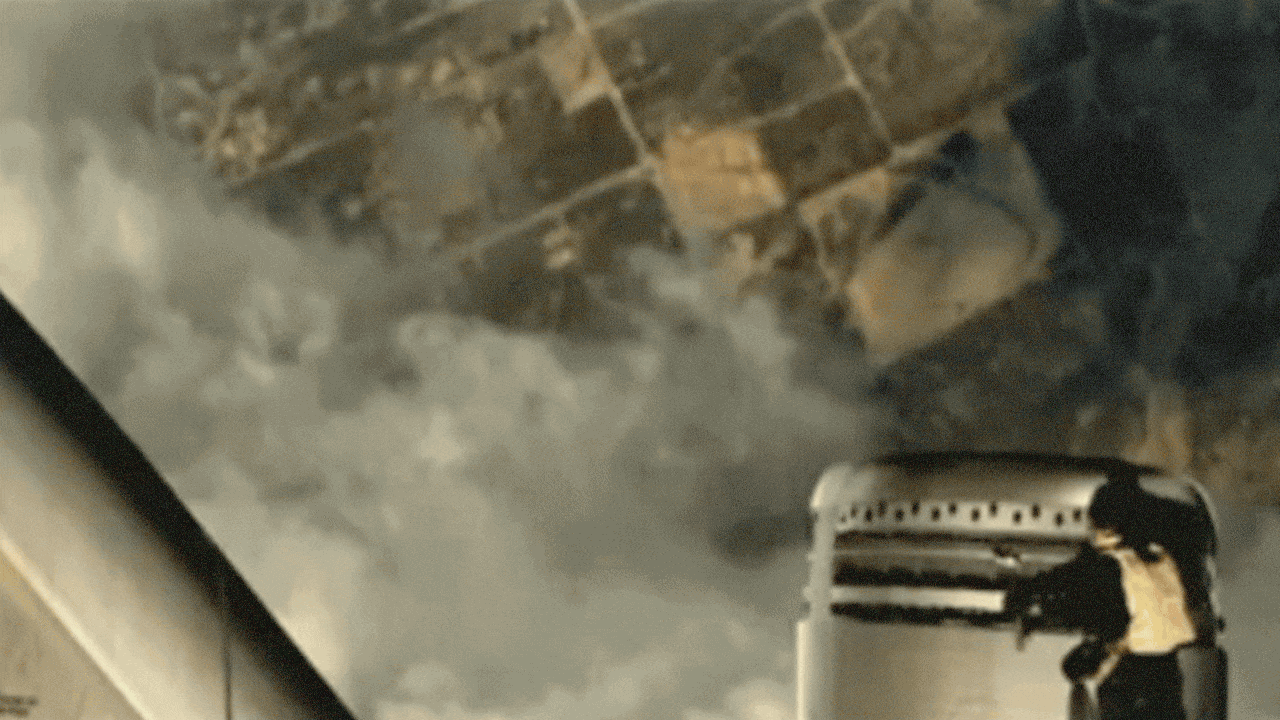
“Airplane” was the second in a trilogy of ads for EDS (the others featured squirrels and cat herding). The campaign was developed by Fallon and premiered in the Superbowl on 30 January 2000. See the whole video at AdLand.
By now, we recognize the phrase has been overused and misused to the point that it has no meaning, but as the critics like to point out: the metaphor is often wrong. And it’s simple BS when talking about iterating software running as a service, where change is expected and necessary. It’s what we do, but more on that later.
Also, as improbable as it might seem to some, there’s a lot of precedent for mid-flight repairs and revisions in aviation. I’m not just talking about sci-fi situations, like R2-D2 repairing Queen Amidala’s royal starship, BB-8 repairing the weapons system in Poe’s X-Wing in Last Jedi, or any of the numerous times Montgomery Scott rebuilt, modified, or supercharged the Enterprise’s systems in-flight and mid-episode (though some people think he’s a good model for project managers).
And I’m also not going to focus on the five separate servicing missions to the Hubble while orbiting at about 18,000 miles per hour, about 340 miles above the earth’s surface. Even though those altitude and speed numbers hide the complexity that the HST’s orbit is unpredictable:
The position along its orbit changes over time in a way that is not accurately predictable. The density of the upper atmosphere varies according to many factors, and this means that Hubble’s predicted position for six weeks’ time could be in error by up to 4,000 km (2,500 mi). Observation schedules are typically finalized only a few days in advance, as a longer lead time would mean there was a chance that the target would be unobservable by the time it was due to be observed.
Nor do I intend to spend much time on lighter-than-air craft and the nautical ships that preceded them. Somebody had to build the coffin that Ishmael survived the Pequod’s sinking in, and Alfred Eisenstaedt’s photo of in-flight repairs of the Graf Zeppelin is truly epic. Maritime and Zeppelin crews both prepared for and often executed mid-course repairs, but like any fish tale, this coverage of a rudder repair certainly played up the drama.
And though I could probably mic-drop this post with the following video of people changing the tires on a moving car, I’m going to follow it with true stories about winged aircraft:

Don’t you wish you had context and background for this video? Me too. Sadly, there is none given. See the whole video on YouTube.
The golden age of endurance flights
For a period of time after the introduction of any technology, people spend time exploring what they can do with it. Aircraft were no different. The desire to push boundaries led pilots to cross oceans, and eventually circumnavigate the globe by air. And after meeting those challenges, pilots continued to ask: how far, how high, how long?
Air-to-air refueling allowed pilots and their aircraft to out-fly the limits of their fuel capacity, and soon they started setting endurance records for refueled flights. On 7 January 1929, Carl Spatz and four other members of the Army Air Corps landed their Atlantic-Fokker C2A named “Question Mark” for the first time in about six days. One of the problems the crew had to overcome was communication. According to the Air Force Museum:
Due to the unreliability and extra weight of air-to-air radios, the Question Mark and refueling planes did not carry radios. The aircrews communicated with hand signals, flashlight signals, ground panels, notes dropped to the ground, and by messages written on blackboards carried in the planes.
The communication worked. Forty-two times the crew met in formation with support aircraft to take on fuel, oil, food, and water, and they were forced to land only because the engines failed after continuous operation for 150 hours, 40 minutes and 14 seconds.
To prevent foreshortened flights due to mechanical failures, pilots had to figure out how to do basic engine maintenance in the air. Reginald Robbins and James Kelly started their attempt at a record in May 1929 with the addition of an exterior catwalk that allowed Kelly to step outside the cockpit and make his way forward to the engine to grease the rocker arms in the pair’s Ryan B-1 monoplane. Despite these efforts, Robbins and Kelly were forced down shortly after seven days due to damage to the propeller caused by Kelly’s belt striking it.
The summer of 1929 saw three more records set, all in July, extending the duration to just over 17 days. At least one of those records copied the Robbins and Kelly catwalk, and by July 1930, brothers John and Kenneth Hunter were ready with their version of the catwalk for their attempt.
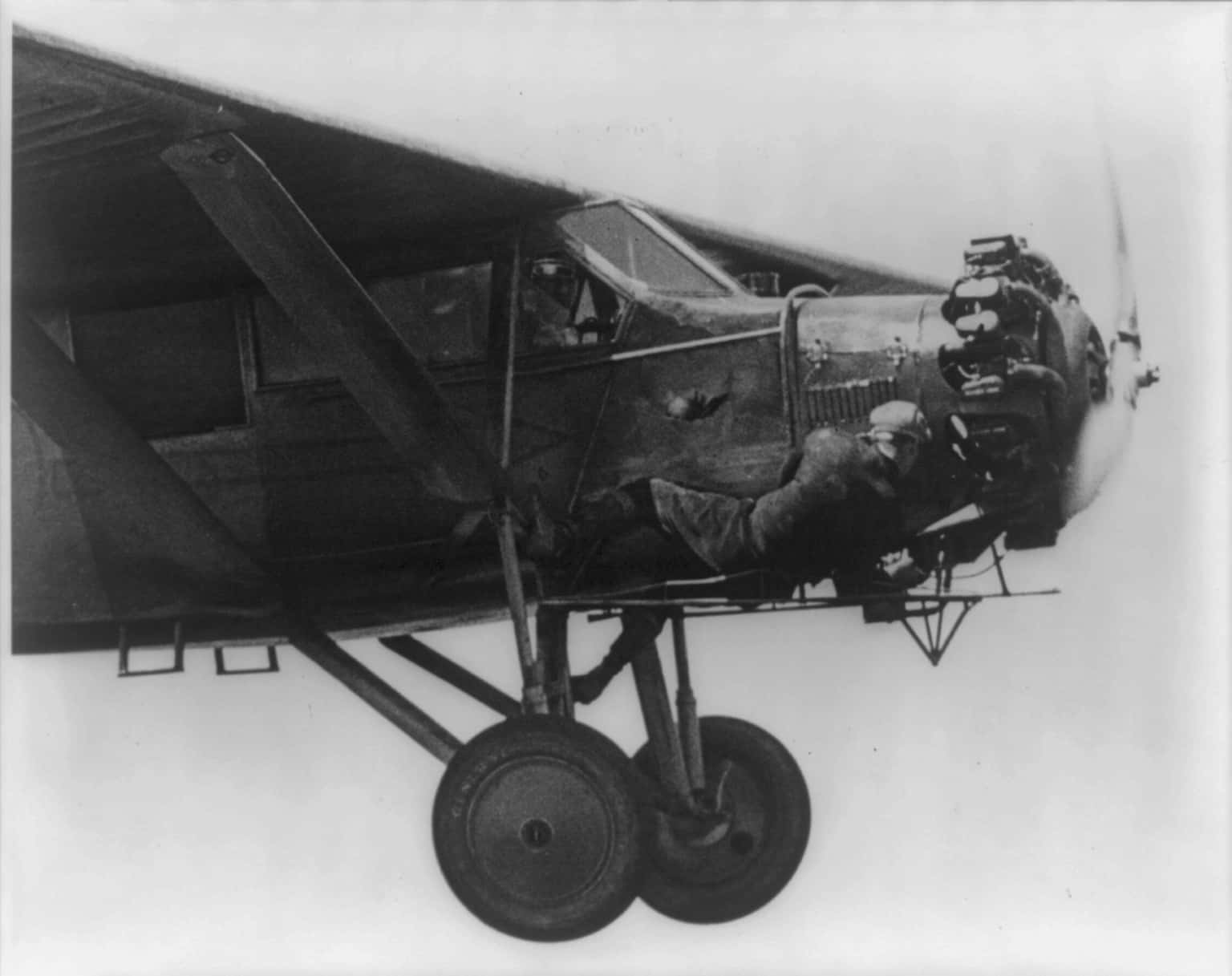
Kenneth Hunter greases the engine while his brother John flies the plane. Library of Congress collection.
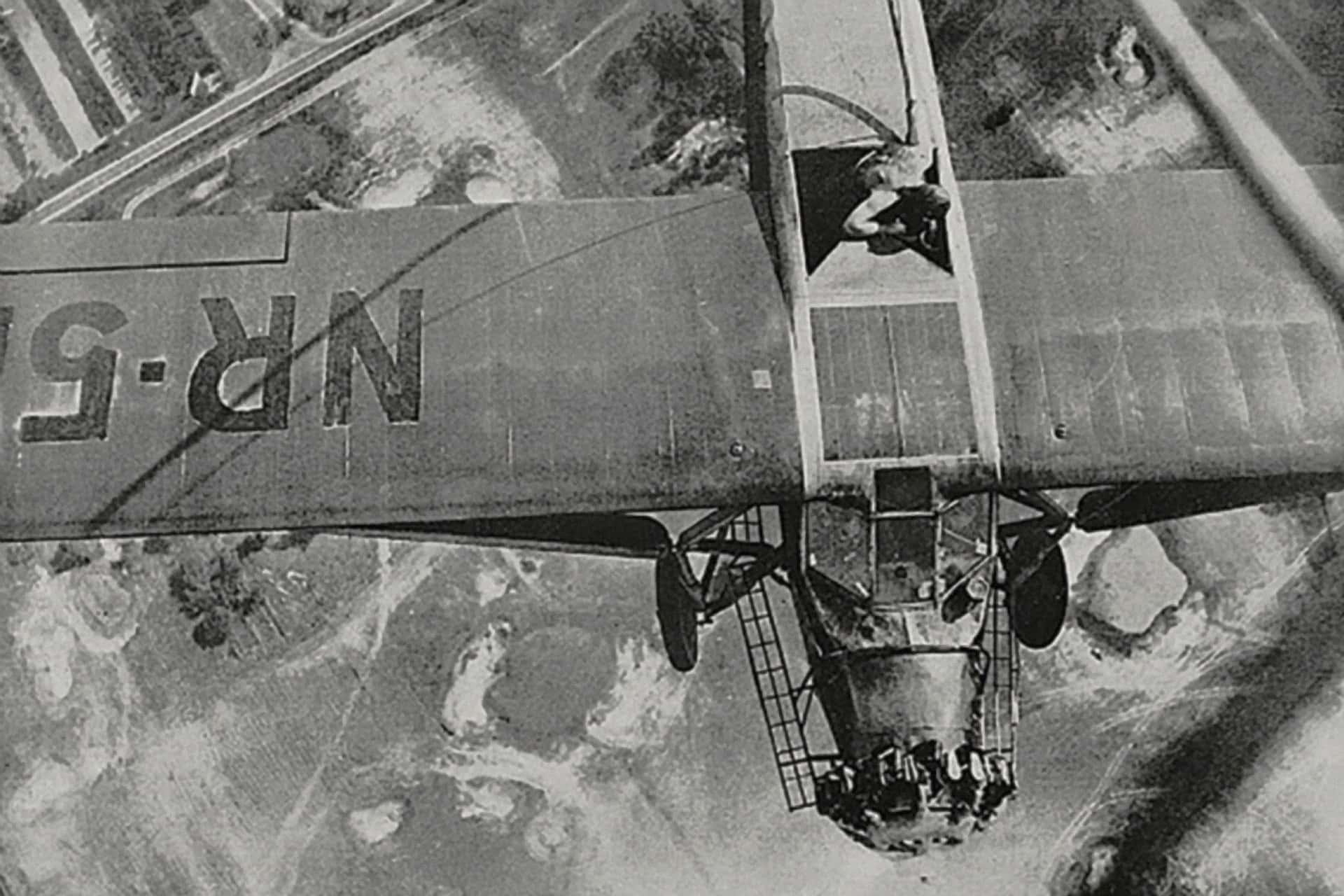
John and Kenneth Hunter’s “City of Chicago” as seen from the refueling plane above. Note the catwalk extending on either side of the fuselage from cockpit to engine. Appeared in HistoryNet.
After three weeks in the air, the brothers were exhausted and too tired to deal with a spate of failures in the oil system:
First, a feed line broke, spurting oil all over the plane. Then the motor began to pump oil. At 6 o’clock the fliers dropped a note, saying that an oil gauge had broken, again draining the oil.
They landed on the Fourth of July and went into the record books with a duration of 23 days, one hour and 41 minutes.
It would take five more years before a new record would be set, this one by another pair of brothers, Fred and Al Key—The Flying Keys. Like many before them, the Keys used a catwalk as well:
They built a kind of scaffold on both sides of the engine so that Fred could clamber out of the cabin and perform maintenance, including servicing the crankcase with oil. After the catwalk was installed, the Curtiss Robin looked like it had collided with a jungle gym, but the idea worked.
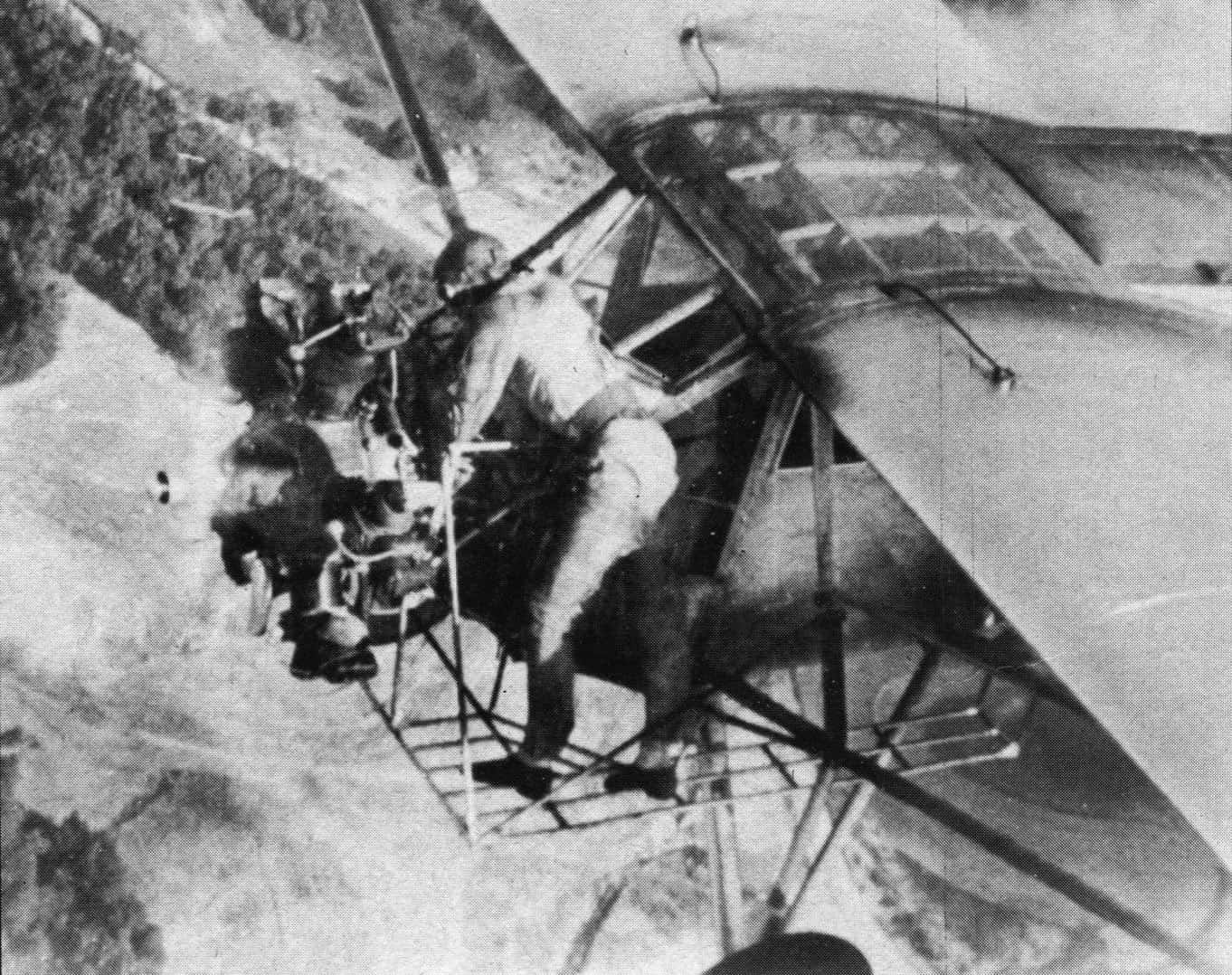
Fred Key performs in-flight maintenance “Ole Miss.” Appeared in the EAA Vintage Aircraft Association’s newsletter.
The brothers copied the catwalk, but they introduced a lasting innovation: a fueling system that started the flow of fuel as soon as the hose was properly connected to the custom tank, and stopped it as soon as it was disconnected—even if the disconnect was a result of buffeting blowing the planes apart. The custom fueling system and check value was designed by local mechanic A.D. Hunter and has been essential to aerial refueling since1.
The pair had made two prior attempts at the record. The first was thwarted on the fifth day by a loose engine cylinder that couldn’t be repaired, even with the help of the catwalk. The second was forced down after seven days by stormy weather that made refueling too dangerous to attempt, and which they couldn’t fly above or around.
The brothers started their third attempt quietly, but national recognition started to build after their tenth day. Then 20 days into the flight, Al Key had to lance his gums to relieve swelling from an abscessed tooth. A dentist gave instructions over the radio. A few days after that, on the same day the pair surpassed the previous record, they discovered one of the tires had lost air pressure, but it was out of reach for repair and wouldn’t be needed until they attempted their landing anyway.
Twenty-five, maybe 26 days in—sources differ—the plane caught fire:
During a refueling, one of the metal oil cans came in contact with some exposed electrical wiring in the plane, which caused a short circuit. A fire broke out and the plane, newly filled to capacity with gasoline, appeared ready to go down in flames. Al was flying and he cut the engine as Fred grabbed a fire extinguisher and blasted the flames — luckily, the fire went out, leaving the plane filled with smoke. Al pulled out of the dive, restarting the engine, less than 100 feet from the ground.
The brothers and the plane had been buffeted by storms during the flight. Multiple reports say the stabilizer was weakened in the storms, but the pilots could be forgiven for just being exhausted. The pair landed safely—despite the flat tire—after 27 days in the air.
A new generation of endurance
Wes Carroll and Clyde Schlieper incremented the record a bit in 1939, flying in a Piper Cub on floats2 that was refueled and serviced by doing low passes in formation with a speeding convertible. The pair landed without any critical mechanical trouble after meeting their goal to stay aloft for 30 days.
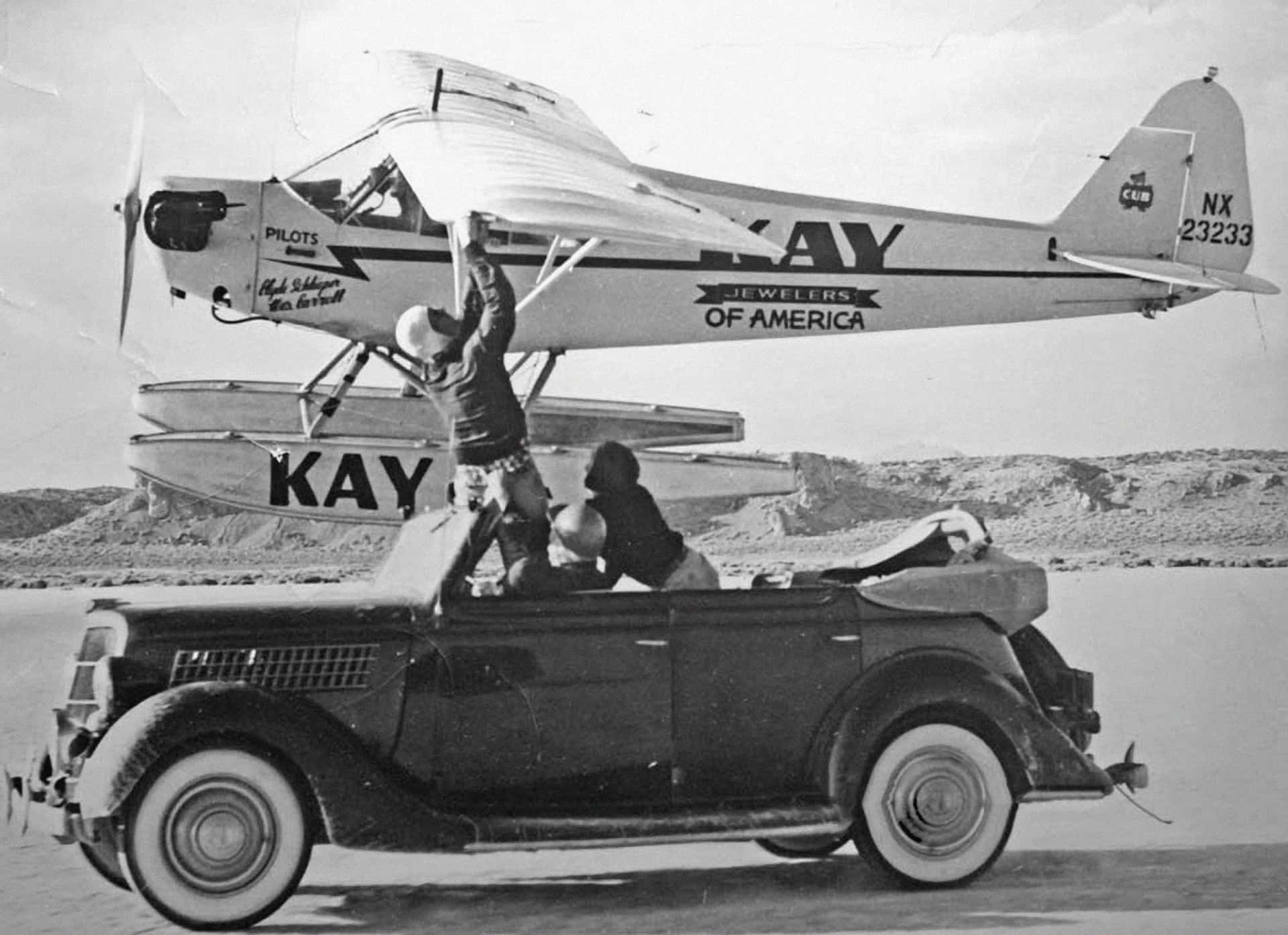
Wes Carroll and Clyde Schlieper were kept aloft thanks to canned fuel and other supplies passed up from a fast-moving 1935 Ford convertible. This picture also appears to demonstrate servicing the wingtip navigation light. Appears in The Old Motor.
The Key brothers’ comparatively large plane consumed 6,000 gallons of gasoline and 300 gallons of oil during their flight, but Carroll and Schlieper’s much smaller Piper and its 50 horsepower motor consumed less than 3,000 gallons, despite the extra days aloft (I’ve found no record of the oil consumption).
Aviation was starting to change by the late 1930s. Aircraft manufacturers believed that aviation would follow the same pattern that automobiles had just a generation earlier: the vehicles would evolve from oddities to daily necessities. The Piper J3 Cub—and the Aeronca Sedan and Cessna 172 that followed in postwar endurance attempts—represented a new generation of aircraft. These plans were designed for the expected thriving market for private planes, or automobiles of the sky. They were designed for mass production, easy flying, and high reliability.
The Piper J3 was also powered by a new generation of engines. By summer 1939, three different 50 HP engines had been certified for Piper J3 models:
- Continental A-50-1 (including -2 to -9 variants)
- Franklin 4AC-150 Series 50
- Lycoming O-145-A1
All three engines were introduced just the year before, in 1938, and featured modern improvements not seen in the engines of most earlier endurance competitors. These include pressurized oil systems with spray lubrication of the cylinder walls and pistons, as well as tighter tolerances that led to more reliable operation. The 165 HP Wright J-6-5 Whirlwind in the Keys’ Curtis Robin J-1 had been first introduced in 1928. The engines in the attempts before that were practically made out of stone.
World war delayed endurance attempts for a decade, but from 1949 to 1959, four new records would be set. The last would more than double Wes Carroll and Clyde Schlieper’s 30 days in flight.
Dick Riedel and Bill Barris flew an Aeronca Sedan into the record books in early 1949. The pair took off from Fullerton, California, but flew as far as Miami to avoid storms before returning to Fullerton. A support crew accompanied the duo in a second plane, landing at airports to organize resupply runs using local equipment along the flight path. The pair made four attempts at the record, the first we stymied by undescribed issues, but their last seemed to go without difficulty other than weather. The pair landed after 42 days aloft, 12 days more than the previous record.
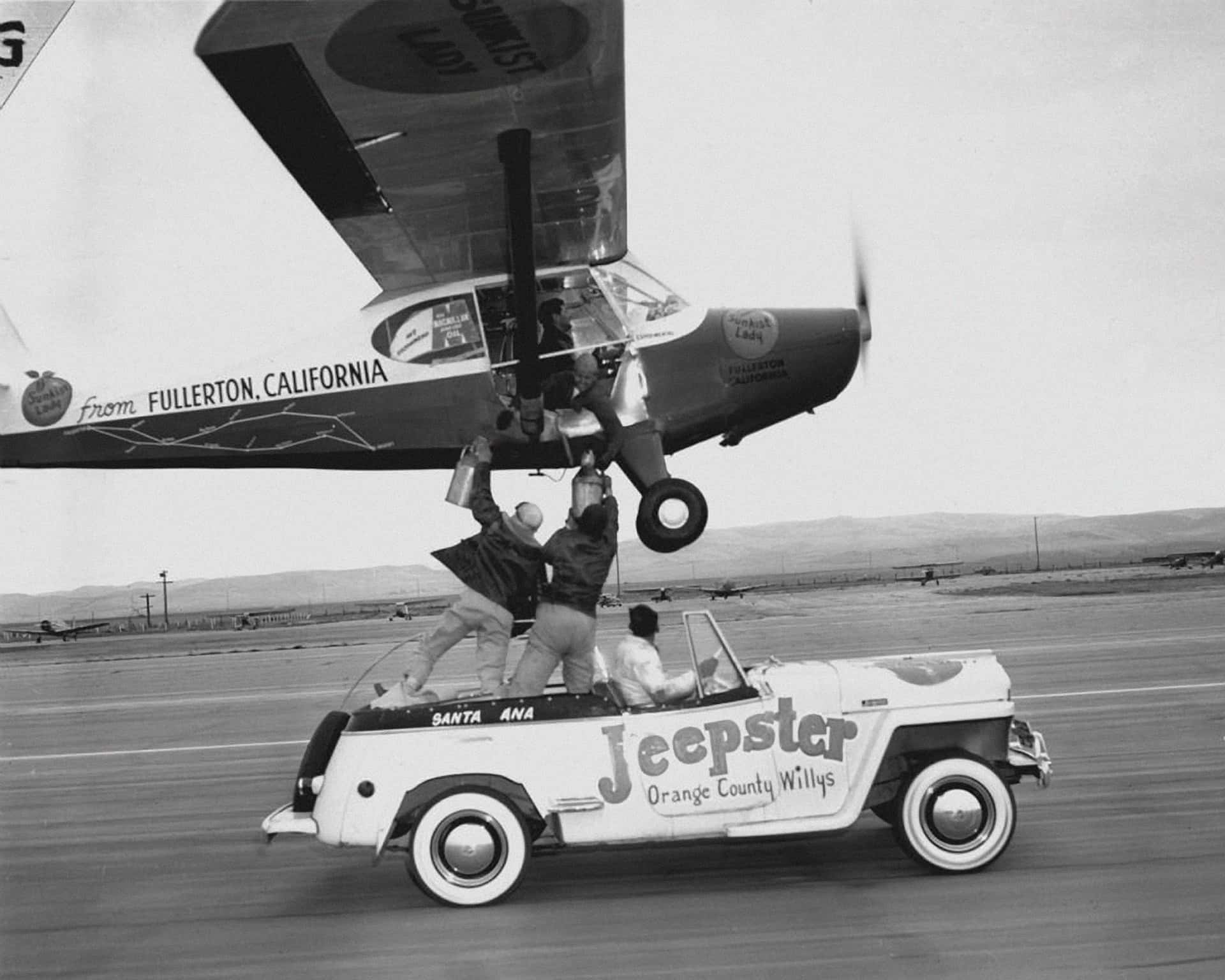
Dick Riedel and Bill Barris form up with a Jeepster to take on supplies during their 1949 record flight. Ground resupply became the norm for endurance record attempts in 1939 and after. From Calisphere and Orange County Public Libraries.
The new record didn’t last long. Just a few months later, Bob Woodhouse and Woody Jongeward took off in an Aeronca Sedan of their own from Yuma, Arizona. It was the pair’s third try at the record, but they finally landed more than 46 days later with a record that held for almost nine years.
It was 1958 before another record would be set. Jim Heth and Bill Burkhart piloted their Cessna 172 through a hot Texas summer for 50 days aloft. Nothing has been reported about in-flight trouble, and Continental Engines used the record to crow about their reliability. In the end, the pair seemed to be happy with their achievement and landed without issue.
Robert Timm was a slot machine mechanic at the Hacienda hotel and casino in Las Vegas, where owner Doc Bailey needed a publicity stunt. Timm was passionate about flying and Bailey was willing to gamble on a plan to best the 50 day record. Timm found a plane, emblazoned the Hacienda’s name on the side, and set himself to other preparations.
Timm and his mechanic, Irv Kuenzi, selected a Cessna 172 manufactured in early 1958, added an extra 95-gallon fuel tank slung on the belly of the plane, and rerouted the oil lines so oil and filters could be changed from inside the cockpit3. An electric pump was installed to move fuel from the belly tank to the wing tanks, and an electric winch to play out and haul in the hose they’d use during refueling runs.
They removed all the seats except the pilot’s, as well as the copilot’s door. For comfort, they added a small sink behind the pilot and put down a foam pad to replace the missing copilot’s seat.
The original engine had 450 hours on its clock, but Timm was able to convince Continental Motors to sponsor them with a brand new one. Timm also had some ideas about how to prevent or clean carbon deposits during the flight:
Timm, also a certified airplane mechanic, had one additional modification he wanted to make to the airplane. He had Kuenzi install a primer-like system he had designed that would squirt alcohol into the combustion chamber of each of the engine’s six cylinders. It was Timm’s belief that this alcohol injection system4 would help prevent the buildup of carbon in the combustion chambers. Kuenzi did not agree, and fought Timm on this. However, he eventually conceded.
With an unnamed copilot, Timm made three attempts. Early one morning, Timm noted, “the entire sky lit up.” He later learned that he’d witnessed a nuclear test. Despite their preparation, they were dogged by engine problems, including burned exhaust valves, that forced them down early each time.
Irv Kuenzi, Timm’s mechanic, tried to solve the problems as best he could. He replaced the now ruined new engine with the used engine that was in the plane when they bought it, and:
Acting on a hunch, and without telling Timm, Kuenzi also disconnected Timm’s alcohol-injection system. He rerouted it so that the alcohol would now be pumped out the bottom of the lower cowling.
For the fourth attempt, Timm replaced the copilot with John Wayne Cook, who’s bonafides included piloting for airlines and work as an aircraft mechanic. The pair took off on 4 December 1958.
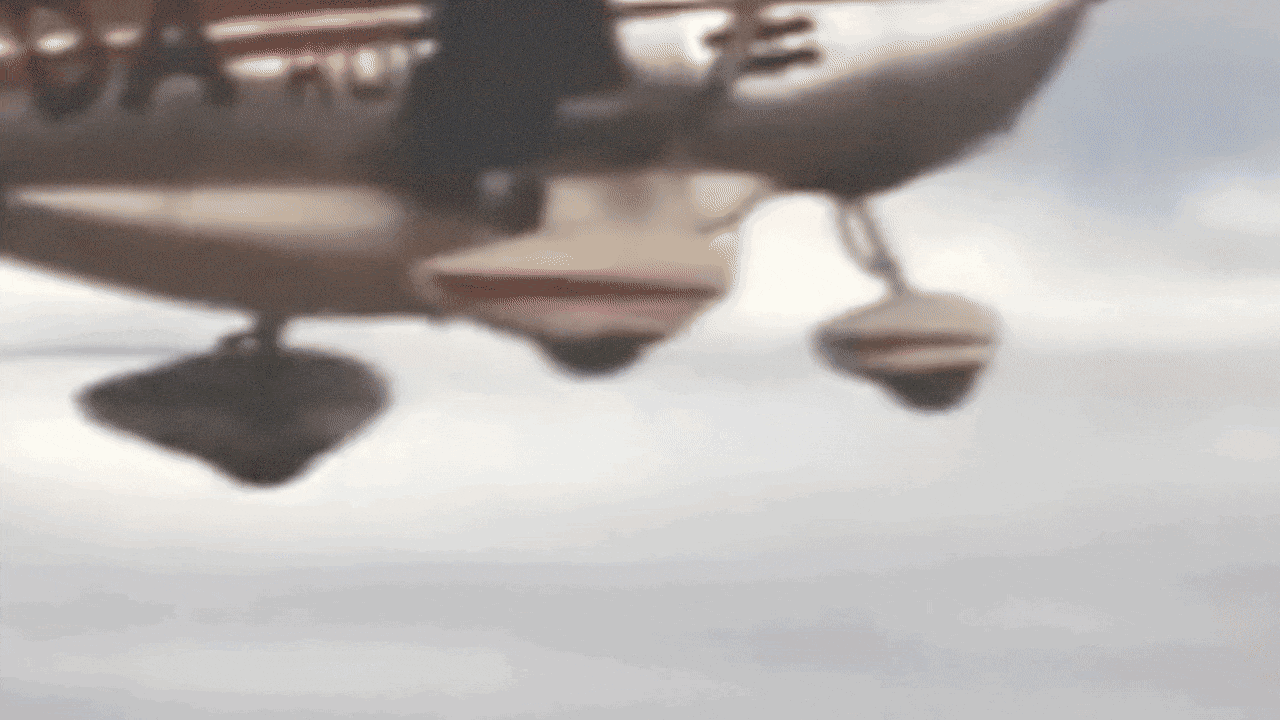
Robert Timm and John Wayne Cook refueled by pumping gas up from a pickup truck while the formation cruised at about 70 miles per hour along deserted highways and dry lake beds. Their plans called for two refueling runs daily.Clips from the Howard W. Cannon Aviation Museum and Nevada Aerospace Hall of Fame.
Thirty-nine days in, the generator failed, leaving the duo without heat, lights, or two-way radio, and disabling the electric winch and pump they depended on for fueling. A few days later the ground team passed up a small wind turbine to mount on the wing strut, but it wasn’t powerful enough to keep everything running. Timm and Cook would suffer cold weather and hard labor of pumping fuel and hauling in the hose by hand through the rest of the flight.
And yet they persevered. Having invested so much in their effort so far, felt obligated to continue even after besting the previous record. For two more weeks, they carried on with their daily routine of four-hour shifts and regular high-speed meetups with the resupply truck.
Even if the pilots were eager to continue, the engine was not. The accumulation of carbon deposits that Timm had dreaded was becoming so great that the engine was struggling to produce enough power to climb away when fully loaded after resupply runs5. The pair landed safely back at Las Vegas McCarran Field 64 days, 22 hours, and 19 minutes after they first took off. They had celebrated Christmas and New Years’ aloft and set the endurance record that stands to this day.
Epilogue to Robert Timm and John Wayne Cook’s flight
When asked if he would ever attempt it again, Cook answered:
Next time I feel in the mood to fly endurance, I’m going to lock myself in a garbage can with the vacuum cleaner running, and have Bob serve me T-bone steaks chopped up in a thermos bottle. That is, until my psychiatrist opens for business in the morning.
A few video clips can be seen in productions from the Howard W. Cannon Aviation Museum and Nevada Aerospace Hall of Fame.
In 1995, Flying Magazine reported that pilot Dean Charron was trying to assemble sponsorship to attempt a challenge to the record. Charron’s name did not appear in any subsequent issues of the magazine.
Legacy and metaphors
This is a long post, so it’s worth summarizing: Repairing boats, airships, planes, and spaceships in-flight is common, though this post only gives detailed examples from endurance flights of fixed-wing aircraft.
It could be argued that none of the endurance flights described here truly demonstrates “building the plane while flying it.”
Whatever. These pilots did in-air maintenance and repairs—changing oil and filters, rewiring electrical systems—that most people can’t do on cars in their driveway. These pilots weren’t trying to make fodder for metaphors, they were trying to see how long they could stay aloft. Some did it for the challenge, others were desperate to save their airfields.
All attempts demonstrated a willingness to take on problems, and the skill or luck of finding solutions to the most critical problems they faced. Many could probably have devised ways to replace a wing or engine in-flight if doing so were necessary to incrementing the record.
Some have claimed that the race for endurance records had “no more practical value than flagpole-sitting.” That claim is clearly false: It ignores the aerial refueling system invented by A.D. Hunter and demonstrated in Al and Fred Key’s 27-day flight, and which remains in use today.
But it’s admittedly hard to see the resemblance between heavily modified aircraft used in those endurance efforts and the aircraft of today, and perhaps we can be forgiven for thinking they all led to dead ends.
Pushing boundaries often requires dead-end work
The catwalks that many early endurance flyers built on their planes to service the engines in flight were crazy then and they’re crazy now, but they were necessary to support more frequent and complex engine maintenance that was needed on the engines of that era. The record-winning aircraft of 1939 and later didn’t feature those catwalks because their more reliable engines didn’t require them.
The improvements to aircraft and engine reliability that led to the records in 1939 and after were part of larger market movements, not driven by the endurance attempts. Critics could argue that the flyers could have sat on the ground and waited for better engines, but these flyers were doers who were willing to see their way around the limitations of those engines, even if their efforts were technical dead ends that resulted in throw-away work.
Better communication tools contributed to higher endurance
Amazingly, early endurance efforts had to be executed without the aid of radio communication. These early flyers had to precoordinate their resupply efforts and use hand signals to communicate conditions and needs.
The first major use of radio in aircraft was in Commander Richard Byrd’s 1928-1930 Antarctic Expeditions, but brothers John and Kenneth Hunter did their record 23 days in the air in 1930 without a radio. In 1933 it was advised that it was best to mount the radio in the rear of the fuselage, presumably because it was too large to install in the instrument panel. The radio in a newly introduced 1937 twin-engined Bloch was reported to weight 220 pounds, but by 1946, the typical radio set weighed ten pounds. By the time of Robert Timm and John Cook’s 1959 flight, radios were light and common enough that they carried two.
Al and Fred Key’s 1935 attempt may have been the first aided by two-way radio communication, and it may have been critical making their record when Al’s abscess tooth incapacitated him 20 days in. Fortunately, the ground crew was able to find a dentist who could talk the brothers through the procedure to drain the abscess over the radio. Would the condition have forced them to end their early and fall short of the record if they had not had the radio?
Paradoxically, radio communication also created a new failure mode: When the generator in Robert Timm and John Wayne Cook’s craft failed, they were left with the charge remaining in the battery to power their radio and maintain communication. Their efforts to jerry-rig the wind turbine on the wing strut kept their radios working and saved their flight6.
No daredevils here
These pilots risked death, but they weren’t daredevils. They carefully analyzed the problems they faced and prepared for them. They kept journals they used to track and adjust their efforts. They moved cautiously and learned from their failures.
The pilots appear to have been constantly on the lookout for safe landing spots should they need them, often avoided populated areas, and coordinated with local officials to avoid risk to those not participating in the flight.
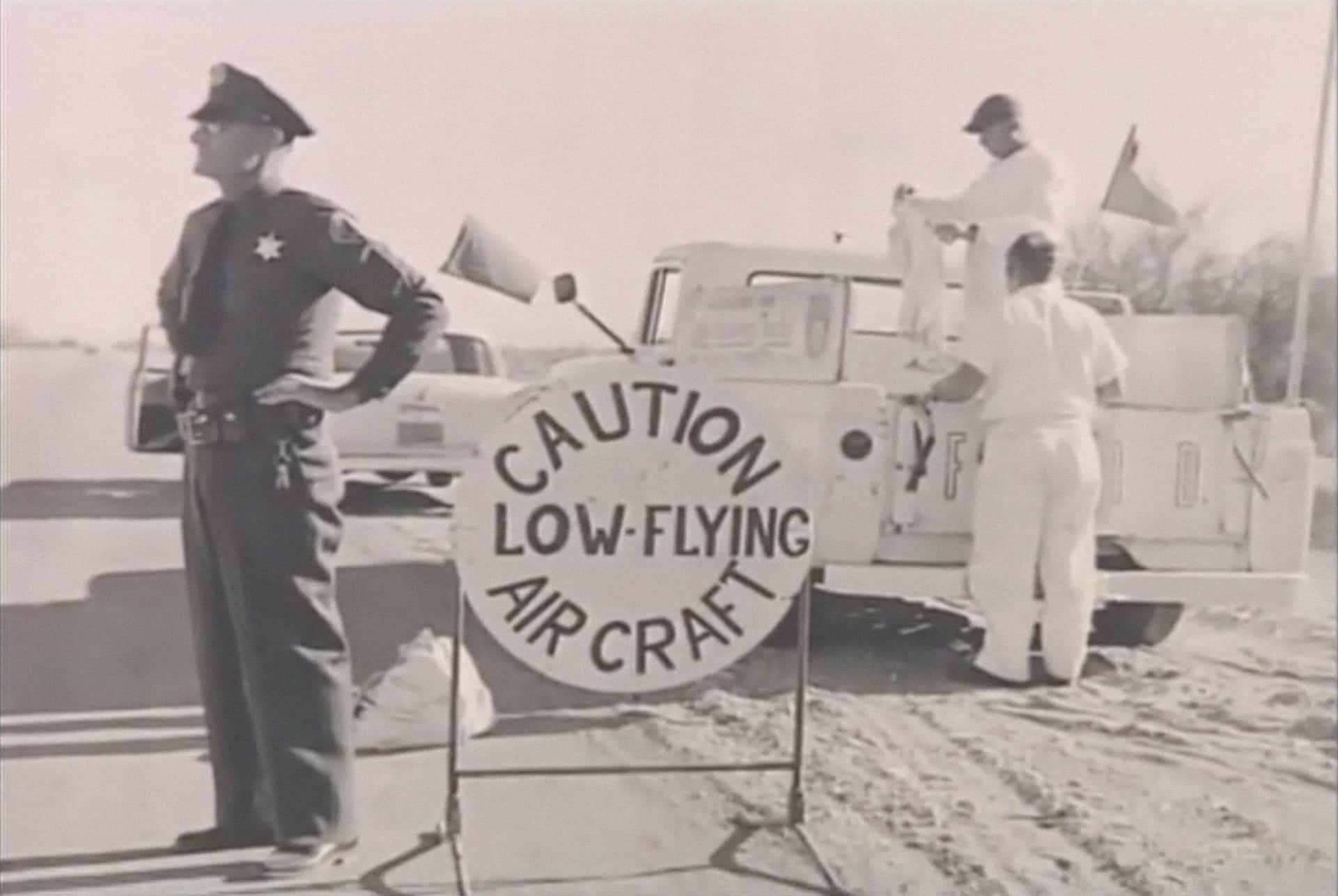
A highway patrol officer blocks the highway while the ground crew for Timm and Cook prepare the resupply truck. Photo shared by Steve Timm.
To reduce fatigue7, pilots on these endurance flights established and kept to schedules as much as they could. Refueling was done regularly during the day, and they avoided refueling at night where they could. Flyers and ground crew planned and practiced their new activities ahead of their record flights, doing what they could to form repeatable patterns. Pilots observed daily routines for personal needs, with regular meals, sleep, and hygiene breaks.
Where possible, these pilots also automated their operations. The Keys automated the valves in their air-to-air refueling system, and a few flyers enjoyed autopilot8—notably, Robert Timm and John Cook9. But, their preparation and automation often needed to be augmented with lessons learned in the air and the changing condition of their aircraft.
Failures were more instructive than successes, willingness to try was more important than skill
Wikipedia’s list of records tells the story of the survivors, but many of those flyers—especially later flyers as the record stretched into weeks aloft—made multiple attempts. And the records of those flyers whose attempts didn’t earn a record appear to be lost to history.
The narrative of these records includes flyers who made repeated attempts, changing and adjusting their approach based on what they learned, but it also includes flyers who were successful on their first try and face few or no problems.
These flyers were certainly skilled, but it’s impossible now to fully pick apart the different roles preparation, luck, or skill played in each attempt. What we do know is that each record-winning attempt happened because somebody decided to give it a try, and to see the idea through to completion. For some it was a lark, others were persevering despite prior failures.
We remember the flyers, but this was a team effort
Every record-breaking flight was supported by a team of people who fueled and fed the flyers, did remote tech support, helped them work through at least one medical emergency, and encouraged them along the way. The way the stories tell it, the entire city of Yuma, Arizona, supported Bob Woodhouse and Woody Jongeward’s 46-day record in 1949, and that support was a common theme among most of the record attempts (though some attempts started quietly and only gained support after showing success).
The conflict between Robert Timm and Irv Kuenzi over alcohol injection is a wonderful demonstration of the fallibility of leaders and proof of the importance of those who support the mission. Still, it’s amusing to imagine how Timm might have responded when he learned Keunzi had disconnected the alcohol injection system.
The Unrelenting demands of continuous operation
The “building the plane while flying it” metaphor is most often invoked when changes are being made to established processes or procedures. Like the record-breaking pilots above, most successful people—most successful businesses—develop mechanisms to reduce the likelihood of bad outcomes. But successful people and companies also need to find ways to change the mechanisms and procedures they use.
Many of the industries in which the metaphor has been used do face real risks. Bad decisions10 in health care or education have real life or death consequences for the people involved. But the history of these domains reflects regular, sometimes dramatic changes that have reshaped those fields and the services they provide.
The most important lesson these flyers can give us is that doing anything for long enough requires accommodating and integrating changes in how you do it. Sometimes those changes happen in the air—whether it be the maintenance the flyers had to do on their craft or the accommodations Timm and Cook had to make after their generator failed.
Those that are lucky or skilled enough to maintain uninterrupted operations for long periods are revered. Those that can figure out how to deliver improvements without interruption are the real heroes.
-
Another aspect of in-flight refueling to consider: static electric discharge between vehicles. Before any fuel could be exchanged, the Keys first connected a ground wire that was paired with the fuel hose, to balance the electrical charges of the two craft and prevent sparks during the actual fueling. ↩︎
-
It’s very possible that either pilot could step out onto the floats to do engine maintenance, but none of the material I found describes or shows such activity. The pair complained of the small cabin, possibly suggesting they didn’t attempt to step outside it. ↩︎
-
I think this implies they also installed redundant oil filters with a valve to switch which one was active at a given time. Otherwise…it might be possible to remove the oil filter from a pressurized oil system, but replacing it could be difficult. ↩︎
-
It’s possible that Timm was influenced by water and water+methanol injection systems that had been used in aircraft during World War II. Those systems were typically used to increase power for short periods—just minutes at a stretch due to the significant additional engine stress and wear they caused. It’s unsurprising now that the new engine was destroyed by use of alcohol injection, and it was unsurprising to Kuenzi at the time. ↩︎
-
The time before overhaul for the 145 HP Continental 0-300 engine of the time was 1,800 hours, not much more than the nearly 1,500 hours the pair had been aloft by early February, but the engine had 450 hours on it before they started. Debates about how the operating conditions of that flight affected engine wear are popular in aircraft forums to this day. ↩︎
-
Nearly 60 years later we’d give this a term: battery anxiety. ↩︎
-
Endurance flights raise a number of factors contributing to decision fatigue and other varieties of cognitive deterioration, including persistent sleep deprivation and full bladders. ↩︎
-
The first aircraft autopilot was first demonstrated in 1918. It was a particularly dramatic demonstration in which the inventor flew low past the observation stands, close enough that the audience could see his arms held high and away from the controls as the biplane proceeded straight and level. Then, to prove the point, he abandoned the cockpit entirely and stepped out on the wing. Again, the plane flew straight and level, even as the plane’s center of gravity shifted. The inventor landed as a hero. ↩︎
-
Robert Timm tells a story of waking up at the controls after apparently sleeping for two hours while the plane flew south to Mexico on autopilot. He awoke just in time: he was in a canyon approaching elevated terrain and had just enough time to pull up. ↩︎
-
Decision deadlines typically get shorter as velocity increases, but this isn’t a problem unique to aircraft. Even in a car, decisions must be made frequently and quickly. A driver on a rural byway might be able to stop at a fork in the road to consider the route, but that driver risks an accident in doing so. Move that car to a busy interstate interchange, and the driver is almost certain to cause an accident by stopping. The driver faces some risk by choosing the wrong direction, but the risk is substantially higher by not making a decision (driving into the lane divider) or stopping to consider the decision (becoming an obstacle to other traffic).
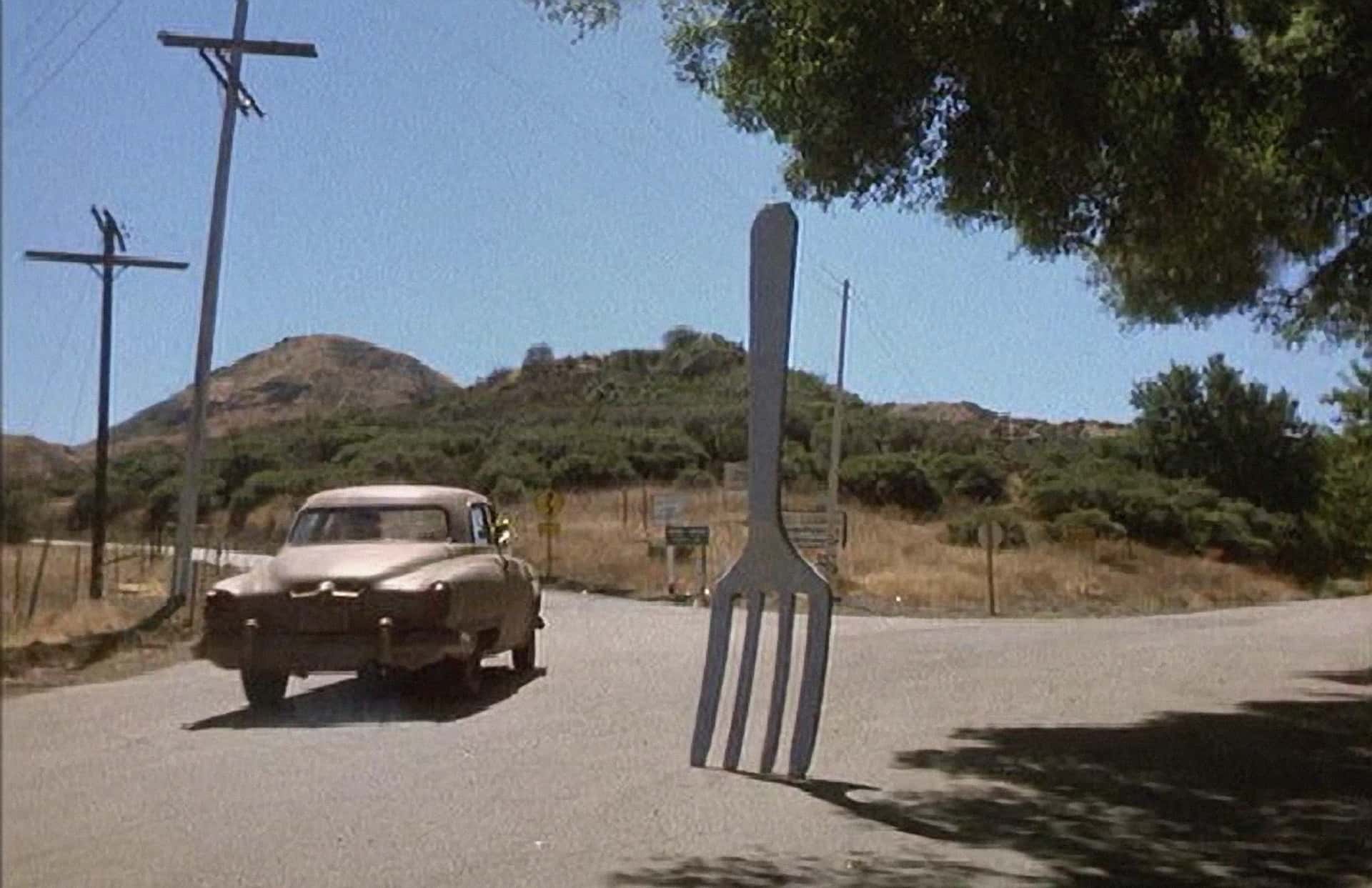
Fozzie Bear driving while Kermit the Frog navigates. Kermit was fortunate to have a map to guide the pair through this fork in the road. Screenshot from The Muppet Movie (1979).
This discussion of metaphors wouldn’t be complete without mentioning that decision deadlines are common to most activities and not specific to transportation. They are, however, very important to doing anything continuously. ↩︎